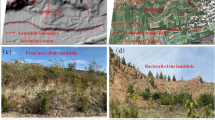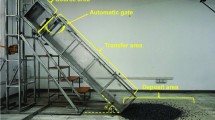Abstract
Increasing number of landslides occurred in the cold regions over the past decades due to rising temperature or forest fires associated with climate change. The instability of thawing slopes caused serious damages to transportation infrastructure, residential properties, and losses of human lives. These types of landslides, however, are difficult to analyze by the traditional limit equilibrium methods due to the coupled thermos-hydro-mechanical multiphysics processes involved. This paper describes a novel microstructure-based random finite element model (RFEM) to simulate the stability of permafrost slope subjected to climate change, including the increasing extent of thawing by warm atmosphere and thermal load due to forest fire. The properties of frozen soil are captured with random finite element model incorporating soil-phase coding. The thermomechanical responses of a permafrost slope are simulated to obtain the temperature, displacement, and stress fields. From these, the local factors of safety are obtained, which predict failure slumps along the slope that are consistent with the field-observed failure behaviors in permafrost slopes. The effects of climate change on the permafrost slope stability are analyzed for the years of 1956, 2017, and 2045. The results demonstrated appreciable amount of effects of climate change on the extent of slope failure zones. Forest fire led to melting of frozen soil and also affects the slope stability primarily in the shallow depth.
















Similar content being viewed by others
References
Alley RB, Marotzke J, Nordhaus WD, Overpeck JT, Peteet DM, Pielke RA et al (2003) Abrupt climate change. Science 299(5615):2005–2010
Arenson LU, Springman SM (2005) Triaxial constant stress and constant strain rate tests on ice-rich permafrost samples. Can Geotech J 42(2):412–430
Badía D, López-García S, Martí C, Ortíz-Perpiñá O, Girona-García A, Casanova-Gascón J (2017) Burn effects on soil properties associated to heat transfer under contrasting moisture content. Sci Total Environ 601:1119–1128
Bishop AW (1955) The use of the slip circle in the stability analyses of slopes. Geotechnique 5(1):7–17
Bo MW, Fabius M, & Fabius K (2008) Impact of global warming on stability of natural slopes. In Proceedings of the 4th Canadian Conference on Geohazards: From Causes to Management, Presse de Univ. Laval, Quebec.
Chamberlain E, Groves C, Perham R (1972) The mechanical behavior of frozen earth materials under high pressure triaxial test conditions. Geotechnique 22(3):469–483
Czurda KA, Hohmann M (1997) Freezing effect on shear strength of clayey soils. Appl Clay Sci 12(1-2):165–187
Davies MC, Hamza O, Harris C (2001) The effect of rise in mean annual temperature on the stability of rock slopes containing ice-filled discontinuities. Permafr Periglac Process 12(1):137–144
Dong S, Yu X (2016) Experimental characterization and microstructure based random FEM simulation of freezing and thawing effects on soils. Geotechnical Special Publication:711–719
Dong S, Yu X (2017) Microstructure-based random finite element simulation of thermal and hydraulic conduction processes in unsaturated frozen Soils. Geotechnical Special Publication:781–790
Dong S, Yu XA (2018) Microstructure-based finite element model to estimate hydraulic properties in fine-grained soils. Geotechnical Special Publication:258–265
Duncan JM (1996) State of the art: limit equilibrium and finite-element analyses of slopes. J Geotech Eng 122(7):577–596
Fenton GA, Griffiths DV (2003) Bearing capacity prediction of spatially random c-φ soils. Can Geotech J 40(1):54–65
Fenton GA, Griffiths DV, Williams MB (2005) Reliability of traditional retaining wall design. Geotechique 55(1):55–62
Frauenfeld OW, Zhang T, Mccreight JL (2007) Northern hemisphere freezing/thawing index variations over the twentieth century. Int J Climatol 27(1):47–63
Griffiths DV, Fenton GA, Manoharan N (2006) Undrained bearing capacity of two-strip footings on spatially random soil. Int J Geomech 6(6):421–427
Griffiths DV, Huang J, Fenton GA (2010) Probabilistic infinite slope analyses. Comput Geotech 38(4):577–584
Gruber S, & Haeberli W (2007) Permafrost in steep bedrock slopes and its temperature-related destabilization following climate change. J Geophys Res Earth Surf 112(F2).
Gruber S, Hoelzle M, Haeberli W (2004) Permafrost thaw and destabilization of Alpine rock walls in the hot summer of 2003. Geophys Res Lett:31(13)
Haeberli W, Beniston M (1998) Climate change and its impacts on glaciers and permafrost in the Alps. Ambio:258–265
Harris C, Davies MC, Etzelmüller B (2001) The assessment of potential geotechnical hazards associated with mountain permafrost in a warming global climate. Permafr Periglac Process 12(1):145–156
Hivon EG, Sego DC (1995) Strength of frozen saline soils. Can Geotech J 32(2):336–354
Janbu N (1973) Slope stability computations. Publication of, Wiley (John) and Sons, Incorporated
Jorgenson MT, Racine CH, Walters JC, Osterkamp TE (2001) Permafrost degradation and ecological changes associated with a warming climate in central Alaska. Clim Chang 48(4):551–579
Kim JW, Lu Z, Qu F, Hu X (2015) Pre-2014 mudslides at Oso revealed by InSAR and multi-source DEM analyses. Geomatics, Natural Hazards and Risk 6(3):184–194
Lu N, Şener-Kaya B, Wayllace A, Godt JW (2012) Analyses of rainfall-induced slope instability using a field of local factor of safety. Water Resour Res 48(9)
Luo J, Niu F, Lin Z, Liu M, Yin G (2019) Recent acceleration of thaw slumping in permafrost terrain of Qinghai-Tibet Plateau: an example from the Beiluhe Region. Geomorphology 341:79–85
McRoberts EC, Morgenstern NR (1974) The stability of thawing slopes. Can Geotech J 11(4):447–469
Morgenstern NU, Price VE (1965) The analyses of the stability of general slip surfaces. Geotechnique 15(1):79–93
Niu F, Luo J, Lin Z, Fang J, Liu M (2016) Thaw-induced slope failures and stability analyses in permafrost regions of the Qinghai-Tibet Plateau, China. Landslides 13(1):55–65
Nixon JF, Lem G (1984) Creep and strength testing of frozen saline fine-grained soils. Can Geotech J 21(3):518–529
Shaoling W, Huijun J, Shuxun L, Lin Z (2000) Permafrost degradation on the Qinghai-Tibet Plateau and its environmental impacts. Permafr Periglac Process 11(1):43–53
Sturm M, Racine C, Tape K (2001) Climate change: increasing shrub abundance in the Arctic. Nature 411(6837):546–547
Thibault S, Payette S (2009) Recent permafrost degradation in bogs of the James Bay area, northern Quebec, Canada. Permafr Periglac Process 20(4):383–389
Wang DY, Ma W, Niu YH, Chang XX, Wen Z (2007) Effects of cyclic freezing and thawing on mechanical properties of Qinghai-Tibet clay. Cold Reg Sci Technol 48(1):34–43
Wang H, Xing X, Li T, Qin Z, & Yang J (2014) Slope instability phenomenon in the permafrost region along the Qinghai-Tibetan highway, China. In Landslides in Cold Regions in the Context of Climate Change. Springer, Cham, pp. 11-22.
Wu TH (1984) Soil movements on permafrost slopes near Fairbanks, Alaska. Can Geotech J 21(4):699–709
Zwiers FW (2002) Climate change: the 20-year forecast. Nature 416(6882):690–691
Funding
This research is partially supported by the Ohio Department of Transportation and US National Science Foundation.
Author information
Authors and Affiliations
Corresponding author
Rights and permissions
About this article
Cite this article
Dong, S., Jiang, Y. & Yu, X. Analyses of the Impacts of Climate Change and Forest Fire on Cold Region Slopes Stability by Random Finite Element Method. Landslides 18, 2531–2545 (2021). https://doi.org/10.1007/s10346-021-01637-1
Received:
Accepted:
Published:
Issue Date:
DOI: https://doi.org/10.1007/s10346-021-01637-1




